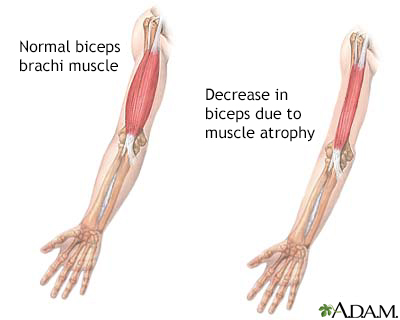Pregnancy SmartSiteTM
Muscle wasting; Wasting; Atrophy of the muscles DefinitionMuscle atrophy is the wasting (thinning) or loss of muscle tissue. CausesThere are three types of muscle atrophy: physiologic, pathologic, and neurogenic. Physiologic atrophy is caused by not using the muscles enough. This type of atrophy can often be reversed with exercise and better nutrition. People who are most affected are those who:
Pathologic atrophy is seen with aging, starvation, and diseases such as Cushing disease (because of taking too much medicines called corticosteroids or having overactive adrenal glands). Neurogenic atrophy is the most severe type of muscle atrophy. It can be from an injury to, or disease of a nerve that connects to the muscle. This type of muscle atrophy tends to occur more suddenly than physiologic atrophy. Examples of diseases affecting the nerves that control muscles:
Although people can adapt to muscle atrophy, even minor muscle atrophy causes some loss of movement or strength. Other causes of muscle atrophy may include:
Home CareAn exercise program may help treat muscle atrophy. Exercises may include ones done in a swimming pool to reduce the muscle workload, and other types of rehabilitation. Your health care provider can tell you more about this. People who cannot actively move one or more joints can do exercises using braces or splints. When to Contact a Medical ProfessionalContact your provider for an appointment if you have unexplained or long-term muscle loss. You can often see this when you compare one hand, arm, or leg to the other. What to Expect at Your Office VisitYour provider will perform a physical examination and ask about your medical history and symptoms, including:
The provider will look at your arms and legs and measure muscle size. This may help determine which nerves are affected. Tests that may be performed include:
Treatment may include physical therapy, ultrasound therapy and, in some cases, surgery to correct a contracture. ReferencesBall JW, Dains JE, Flynn JA, Solomon BS, Stewart RW. Musculoskeletal system. In: Ball JW, Dains JE, Flynn JA, Solomon BS, Stewart RW, eds. Seidel's Guide to Physical Examination. 10th ed. St Louis, MO: Elsevier; 2023:chap 22. Selcen D. Muscle diseases. In: Goldman L, Cooney KA, eds. Goldman-Cecil Medicine. 27th ed. Philadelphia, PA: Elsevier; 2024:chap 389. | |
| |
Review Date: 12/31/2023 Reviewed By: Joseph V. Campellone, MD, Department of Neurology, Cooper Medical School at Rowan University, Camden, NJ. Review provided by VeriMed Healthcare Network. Also reviewed by David C. Dugdale, MD, Medical Director, Brenda Conaway, Editorial Director, and the A.D.A.M. Editorial team. The information provided herein should not be used during any medical emergency or for the diagnosis or treatment of any medical condition. A licensed medical professional should be consulted for diagnosis and treatment of any and all medical conditions. Links to other sites are provided for information only -- they do not constitute endorsements of those other sites. No warranty of any kind, either expressed or implied, is made as to the accuracy, reliability, timeliness, or correctness of any translations made by a third-party service of the information provided herein into any other language. © 1997- A.D.A.M., a business unit of Ebix, Inc. Any duplication or distribution of the information contained herein is strictly prohibited. | |

 Active vs. inactiv...
Active vs. inactiv... Muscular atrophy
Muscular atrophy
